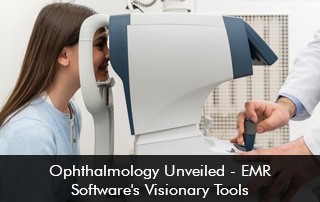Ophthalmology EMR software offers a suite of visionary tools that streamline processes, enhance patient care, and pave the way for a more efficient and accurate practice. Electronic Medical Record (EMR) software also contributes to a data-driven approach that holds the potential to transform the landscape of eye health on a global scale.
The Evolution of Ophthalmic Care: A Glimpse into the Past
To appreciate the impact of EMR software on ophthalmology, it’s crucial to understand the historical context of eye care. Traditionally, ophthalmologists relied on paper-based records, handwritten notes, and manually managed charts. This method, while once the standard, proved to be inefficient, error-prone, and often hindered seamless collaboration among healthcare providers.
Enter Electronic Medical Records, a digital revolution that transformed the healthcare landscape. Initially met with skepticism, EMR systems have now become integral to modern medical practices, including ophthalmology. This integration has given rise to a new era where precision, accessibility, and data-driven decision-making are paramount.
The Visionary Tools of EMR Software in Ophthalmology
Digital Imaging and Diagnostics
One of the standout features of ophthalmology EMR software is its ability to integrate high-quality digital imaging and diagnostic tools. Traditional methods of eye examinations often relied on subjective observations and analog equipment. EMR software brings forth a paradigm shift by enabling ophthalmologists to capture, store, and analyze digital images of the eye.
High-resolution retinal scans, optical coherence tomography (OCT), and fundus photography are seamlessly integrated into the digital infrastructure. This facilitates a more comprehensive understanding of ocular health and allows for precise tracking of changes over time. The result is early detection of ocular diseases leading to more timely interventions and improved patient outcomes.
Interconnected Patient Records Available on EMR Software
EMR software fosters connectivity by consolidating patient records into a centralized digital repository. Ophthalmologists access a patient’s complete medical history, including past eye exams, prescriptions, and surgical procedures, with just a few clicks. This interconnectedness promotes continuity of care, enabling healthcare providers to make informed decisions based on a complete understanding of the patient’s health.
In addition, EMR systems facilitate efficient communication among members of the healthcare team. This collaborative approach ensures that all relevant parties are on the same page regarding a patient’s treatment plan. It also reduces the likelihood of oversights and improves overall care coordination.
Automated Documentation and Reporting
The meticulous documentation required in ophthalmology is a time-consuming aspect of the practice. EMR software introduces automation to this process, allowing ophthalmologists to generate accurate and detailed reports effortlessly. Automated documentation not only saves time but also minimizes the risk of errors associated with manual data entry.
Moreover, these systems often come equipped with customizable templates that cater to the specific needs of ophthalmologists. Whether it’s recording visual acuity measurements, or documenting intraocular pressure readings, EMR software ensures every detail is captured.
EME Software Enhances Efficiency and Workflow Optimization
Time is of the essence in healthcare, and EMR software excels in optimizing workflow efficiency in ophthalmology clinics. From appointment scheduling and check-in processes to billing and follow-up care, these systems streamline every aspect of the patient journey.
Integrating EMR software with appointment scheduling reduces wait times, enhances patient satisfaction, and ensures that no crucial details are overlooked. Additionally, automated reminders and alerts help keep patients on track with their recommended eye care regimen, fostering better treatment plans.
Data Analytics and Population Health Management
EMR software isn’t just a repository of patient data; it’s also a tool for data analytics and population health management. Ophthalmologists leverage data stored in the software to identify trends, track disease prevalence, and implement preventive measures.
By analyzing aggregated data, ophthalmologists contribute to public health initiatives, identify at-risk populations, and tailor interventions for specific community health needs. This data-driven approach benefits individual patients and has the potential to make significant strides in prevention and management.
Challenges and Considerations
While the benefits of ophthalmology EMR software are undeniable, it is essential to address the challenges associated with it. Privacy concerns, data security, and the learning curve for healthcare providers transitioning to digital platforms are among the hurdles that must be navigated carefully.
Moreover, ensuring interoperability between different EMR systems is crucial to facilitate seamless data exchange and collaboration among healthcare institutions. Standardization of data formats and protocols is an ongoing challenge that the healthcare industry as a whole continues to address.
Looking Ahead – The Future of Ophthalmology EMR Software
As technology continues to advance, the future of ophthalmology holds even more promise. Artificial intelligence (AI) integration into EMR software offers the potential for more accurate diagnostics, personalized treatment plans, and predictive analytics.
AI algorithms analyze vast datasets at speeds beyond human capability, assisting ophthalmologists in identifying subtle patterns and trends. This enhances diagnostic accuracy and contributes to the development of targeted therapies for individual patients based on their unique profiles.








